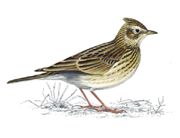| |
|
|
APRIL - THE SKYLARK
Some birds, like the red kite, stand out because they are
spectacular aerial acrobats. Some, like the little goldfinch, have
distinctive colourful plumage. Others, like the heron, literally
stand tall above the
rest.
The skylark is a small brown bird. Between a sparrow and a starling
in size. Whilst on the ground, it is unremarkable, inconspicuous and
silent.
But once in the air, it floats and soars, all the time producing the
most wonderful continuous warbling song. In fact, that is normally how you
will
see the skylark; recognise its distinctive song, scan the sky carefully
and you can usually spot the “small brown bird” fluttering high.
Follow
the bird to the ground, and its song will stop the instant it touches down.
With binoculars, you should be able to see that it is a streaky brown
bird with a small crest, which can be raised when the bird is excited
or alarmed, and a white-sided tail. The wings also have a white rear edge,
which can be seen in flight.
WHERE TO SEE IT
The “Beating the Bounds” walk around the parish boundary on
May Day bank holiday is a good opportunity to spot the skylark,
as the route takes you across its ideal habitat north of Hareway Lane. The
song of the
skylark in April and May is a sure sign that Spring has arrived.
The skylark is a bird of open farmland and can be found on pastureland,
arable fields and rank grassland. It avoids isolated trees and tall hedges.
WIDESPREAD, BUT IN STEEP DECLINE
 Although still widespead throughout Britain, and resident
year round, its numbers have declined considerably in recent years.
In fact, the UK breeding population of skylarks on lowland farmland fell
by 54% between
1969 and 1991. Although still widespead throughout Britain, and resident
year round, its numbers have declined considerably in recent years.
In fact, the UK breeding population of skylarks on lowland farmland fell
by 54% between
1969 and 1991.
Although the rate of decline slowed in the 1980’s, it has continued
since, and the recent and dramatic population decline gives cause for concern.
The skylark is now a “Red List” species.
(This review of British
birds covers a total of 247 species and each species has been placed onto
one of three lists - red, amber or green. Forty species are on the red list,
121 are amber-listed, and 86 are green-listed. To read more about the "Red List" in "The
State of the UK's Birds", click
here.
As a result of considerable reasearch, by the British
Trust for Ornithology (BTO) and others, several reasons have been put forward
to explain the skylark’s
decline. The skylark feeds on seeds and insects, but intensive
management of arable fields has reduced weeds and insect prey through the
use of agrochemicals.
An increased trend to autumn-sown cereals has reduced the number
of essential winter stubble fields and may provide unsuitable breeding habitat
in comparison
with spring-sown varieties. Lowland grassland has been converted
to arable, and grassland itself is now more intensively managed. Finally,
early silage
cutting destroys nests and exposes eggs and young to predators,
while the period between cuts is often too short for successful incubation.
WHAT CAN BE DONE TO HELP
In order to help the skylark, it is becoming increasingly
important that current farming practices are modified to create
a more conservation friendly environment. In particular, an increase in
winter stubbles and
spring-sown cereals, would greatly benefit skylarks. Even within
current farming practices, things can be done. For instance, provision of
beetle
banks away from field boundaries and placing set-aside in large
blocks would create suitable foraging habitat for skylarks.
The RSPB has
recently purchased a 180 hectare farm in Cambridgeshire which
will be used to investigate and develop new “wildlife-friendly” farming
methods to benefit bird species like the skylark. The farm will
allow the RSPB to carry out a detailed programme of research to
devise and test new
cropping techniques, which farmers will be able to incorporate
on farms throughout the UK. The techniques are designed to provide
specific wildlife
benefits currently on trial, and include the provision of uncropped
nesting areas (skylark scrapes), with less intensive cultivation
techniques that
leave seeds in the fields for birds in winter.
Leaflets are available
from the RSPB for farmers, landowners and managers giving advice
on measures to take to help skylarks and other birds.
The skylark is fully
protected under the Wildlife and Countryside Act 1981,
which makes it an offence to kill, injure or take an adult skylark,
or to take, damage or destroy an active nest or its contents. The
only exception is legitimate farming practices that cannot reasonably be
delayed,
although
farming methods can often be modified to reduce the impact on the
skylarks.
For audio and video clips of the skylark on the RSPB website,
click
here.
For more
information on the BTO website, click
here.
[Back to top]
|
|


